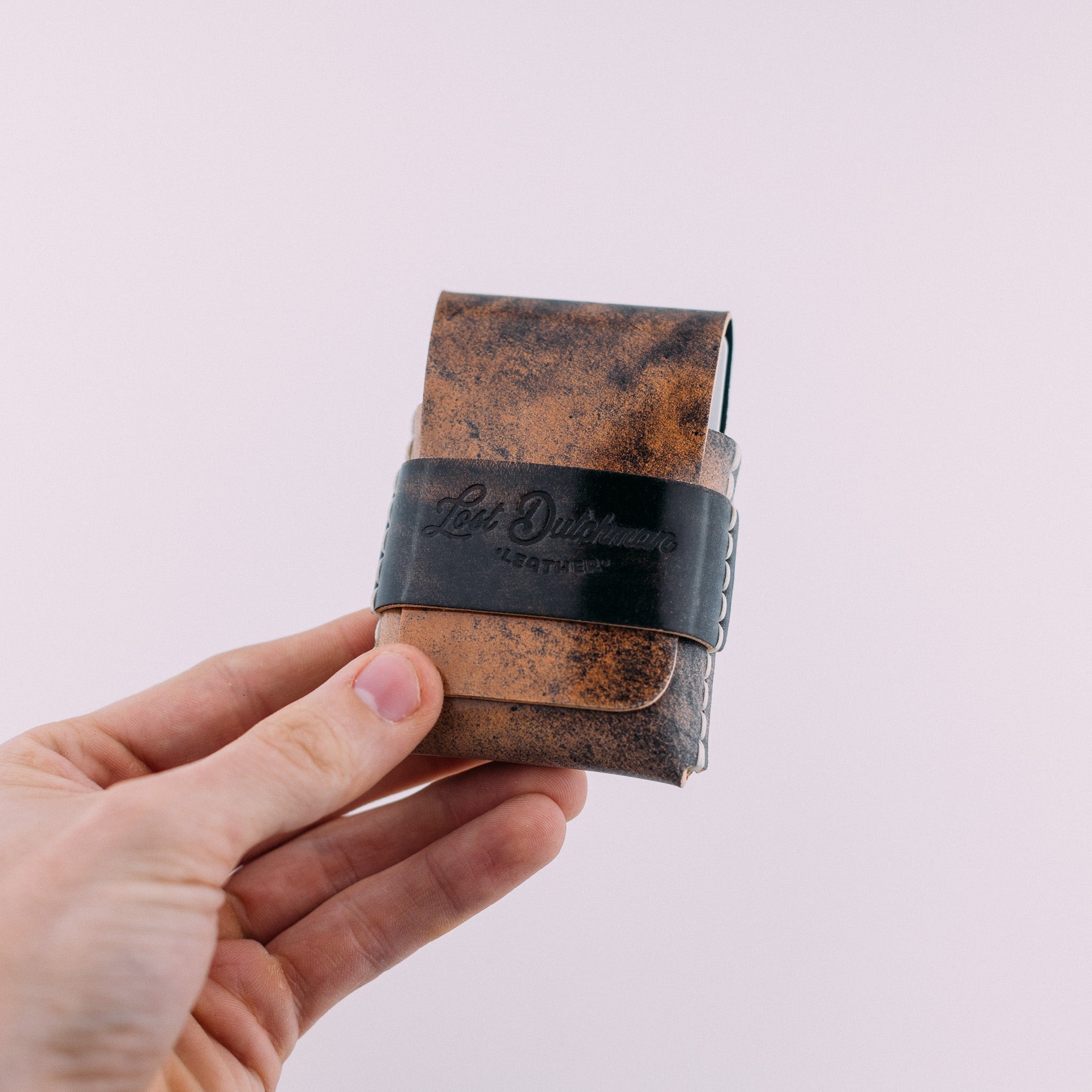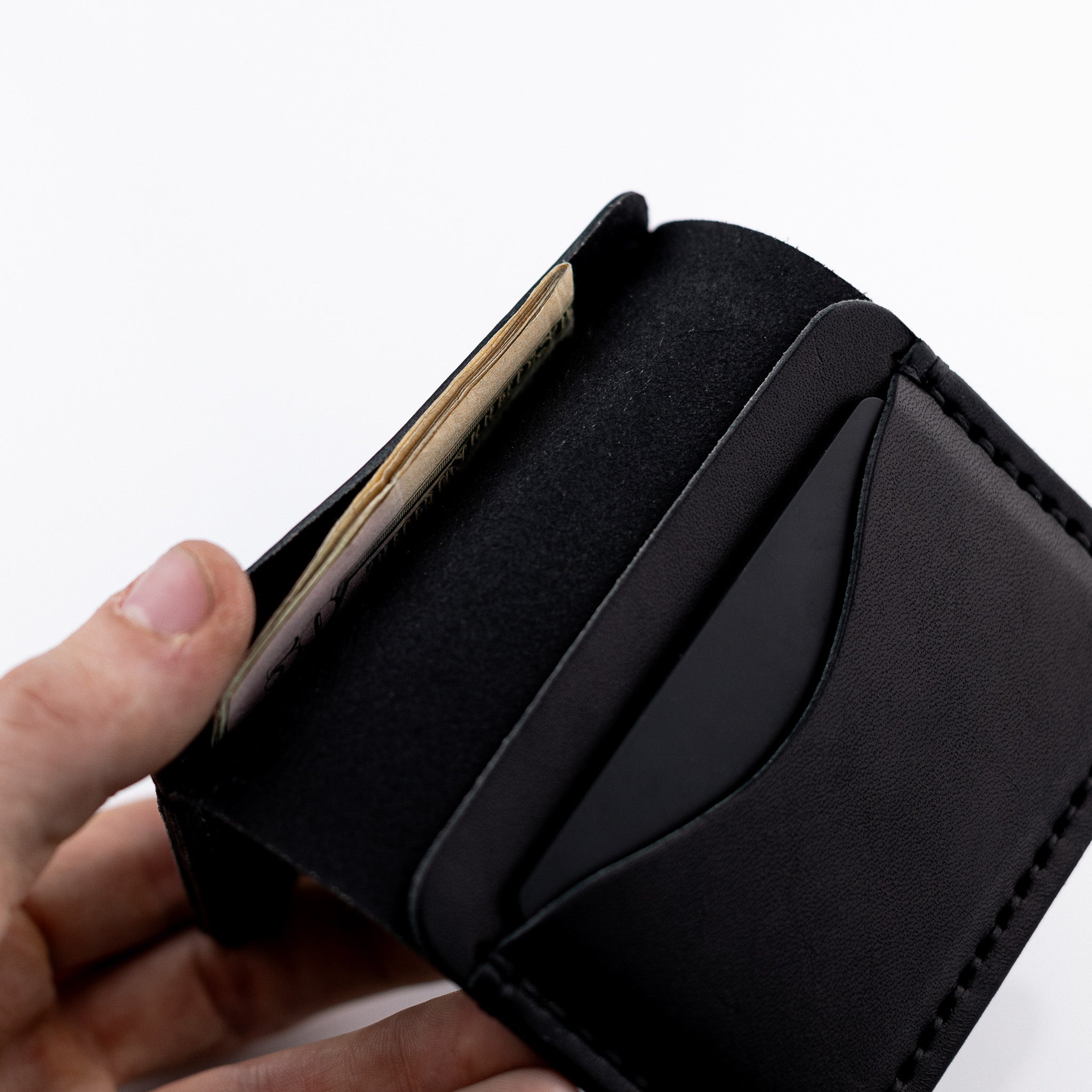
Vegetable-Tanned vs Chrome-Tanned Leather: Pros & Cons
The feel of a wallet or belt in your hands tells you more than any label ever could. Some leather feels rich, sturdy, and ready to age with you; some feels glossy but lifeless, destined to wear out quickly. The difference isn’t just in the cut of the hide, it begins with how the leather is tanned.
Among the types of leather tanning, two methods dominate: vegetable tanning and chrome tanning. They represent two very different philosophies of craftsmanship. One is rooted in slow tradition, patience, and natural materials. The other was born of modern efficiency, making leather accessible on a global scale.
To truly appreciate the goods you carry, understanding leather tanning is essential.
What is Leather Tanning?
Tanning is the process that transforms animal hide into leather that won’t decay. Left untreated, hides would stiffen, crack, and eventually rot. Tanning stabilizes the proteins within the hide, turning them into a material that is both durable and flexible.
Think of it as cooking: raw ingredients on their own aren’t edible. It’s the recipe, the preparation, and the transformation that makes them nourishing. With hides, tanning is that transformation.
There are many tanning techniques practiced throughout history, but vegetable and chrome tanning are the two most common today. Each produces leather with its own look, feel, and long-term behavior.
Vegetable Tanning: The Traditional Art
Vegetable tanning is among the oldest forms of leather-making, practiced for thousands of years. This process relies on tannins, natural compounds found in tree bark, fruits, and leaves.
The hides are soaked in vats filled with tannin-rich solutions. Over weeks or months, the tannins gradually bind with the fibers of the hide, preserving them naturally. The process is slow, meticulous, and deeply tied to tradition.
Defining qualities of vegetable-tanned leather:
-
Distinct earthy aroma.
-
Firm and slightly stiff at first, but softens with use.
-
Variations in tone, reflecting its natural roots.
-
Ages with a patina that deepens and personalizes the piece.
A wallet like The Dutchman showcases these qualities perfectly: durable, simple in design, and able to grow more beautiful the longer it’s carried.
Why Choose Vegetable-Tanned Leather?
People drawn to vegetable-tanned leather value longevity and authenticity.
-
Durability: This leather can last decades, often outliving its owner. Belts from our collection are designed with this endurance in mind.
-
Character: No two hides are alike. The natural tannins create subtle variations in tone and texture, ensuring your piece is one of a kind.
-
Patina: The surface darkens and glows over time, telling a story that’s unique to you.
-
Craftsmanship: Every step of the tanning process reflects patience and skill.
But vegetable tanning has trade-offs:
-
It costs more because time and labor are extensive.
-
It is more sensitive to water, requiring proper care and conditioning. Products like the Limited Leather Coasters are a great introduction, practical items that allow you to appreciate this leather in everyday life.
Chrome Tanning: The Modern Method
In the late 19th century, chrome tanning revolutionized leather-making. By using chromium salts, the process that once took months could now be done in just a couple of days. This efficiency reshaped the leather industry, making leather goods affordable and widely available.
Qualities of chrome-tanned leather:
-
Softer, pliable feel right from the start.
-
Wide range of available colors and finishes.
-
Strong water resistance and less sensitivity to staining.
-
Lower price, making it accessible for mass production.
Chrome tanning dominates today’s market because it is fast, versatile, and cost-effective. That shiny, uniform wallet you see at a department store? Most likely chrome-tanned.
The Advantages of Chrome Tanning
Chrome tanning has undeniable strengths:
-
Speed and scale: Leather can be produced in days, allowing manufacturers to meet global demand.
-
Affordability: Lower production costs mean more affordable products.
-
Color variety: Bright reds, deep blues, sleek blacks, all are possible with chrome tanning.
-
Practicality: The finish provides resistance against water and everyday wear.
For modern accessories designed to match a wide variety of fashion trends, chrome tanning offers flexibility.
The Drawbacks of Chrome Tanning
The same qualities that make chrome tanning appealing also create its weaknesses.
-
Environmental concerns: Without proper regulation, chromium salts can harm ecosystems. Many modern tanneries now practice safer, eco-conscious methods, but the issue lingers.
-
Longevity: Chrome-tanned leather does not age with the same grace as veg-tan. It resists patina, often looking manufactured and uniform for its entire life.
-
Shorter lifespan: While durable enough for everyday use, it simply doesn’t match the decades-long endurance of vegetable-tanned leather.
If vegetable-tanned leather is like a seasoned cast-iron pan that grows better with every meal, chrome-tanned leather is like a nonstick pan, convenient, affordable, but destined to wear out sooner.
Making the Right Choice
When deciding between vegetable-tanned and chrome-tanned leather, consider your values and your lifestyle.
Choose vegetable-tanned leather if you want:
-
A belt or wallet that becomes a lifelong companion.
-
A piece that develops patina, telling a story over the years.
-
Something crafted with slow tradition and authenticity.
Choose chrome-tanned leather if you want:
-
A more affordable entry into leather goods.
-
Bright or unusual colors.
-
Every day practicality with less maintenance.
At Lost Dutchman Leather, our philosophy leans toward the enduring. Pieces like The Belt, The Franklin Wallet, and even modern companions like the AirTag Keyring embody the timeless character of vegetable-tanned leather. They’re not accessories for a season, they’re companions for a lifetime.
The Bigger Picture: Sustainability and Legacy
When viewed through the lens of sustainability, vegetable tanning has clear advantages. Though it requires more resources and time, it uses natural tannins instead of synthetic chemicals. And because a vegetable-tanned piece lasts so much longer, it reduces waste by eliminating the need for constant replacements.
For the customer, this isn’t just a purchase; it’s a commitment. Carrying a card holder made with vegetable-tanned leather is more than a practical choice. It’s a statement about valuing quality over convenience, heritage over haste.
Closing Thoughts: The Art of Choice
Among the many types of leather tanning, vegetable and chrome represent two different philosophies. One embodies tradition, patience, and longevity. The other prioritizes speed, versatility, and affordability. Both have their place, but only one offers a legacy that will last long enough to tell your story.
At Lost Dutchman Leather, we’re committed to the timeless path. Every piece we craft is designed to endure, to patina, and to accompany you for years. From wallets to belts, our work reflects the choice to embrace authenticity.
If you’d like advice on selecting the right product or have questions about our materials, contact us. We’re always glad to share the craft that makes our goods so enduring.

